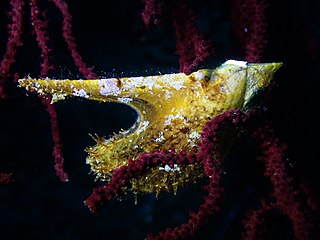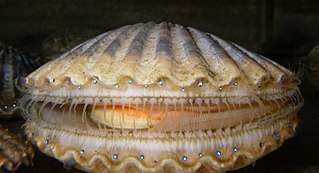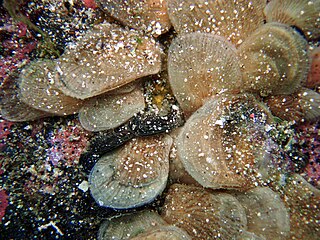
Bivalvia, in previous centuries referred to as the Lamellibranchiata and Pelecypoda, is a class of marine and freshwater molluscs that have laterally compressed bodies enclosed by a shell consisting of two hinged parts. As a group, bivalves have no head and they lack some usual molluscan organs, like the radula and the odontophore. The class includes the clams, oysters, cockles, mussels, scallops, and numerous other families that live in saltwater, as well as a number of families that live in freshwater. The majority are filter feeders. The gills have evolved into ctenidia, specialised organs for feeding and breathing. Most bivalves bury themselves in sediment, where they are relatively safe from predation. Others lie on the sea floor or attach themselves to rocks or other hard surfaces. Some bivalves, such as the scallops and file shells, can swim. Shipworms bore into wood, clay, or stone and live inside these substances.

Pinctada is a genus of saltwater oysters, marine bivalve mollusks in the family Pteriidae. These pearl oysters have a strong inner shell layer composed of nacre, also known as "mother of pearl".

The Pteriida are an order of large and medium-sized marine bivalve mollusks. It includes five families, among them the Pteriidae.

Pteriidae, also called the feather oysters, is a family of medium-sized to large saltwater oysters. They are pearl oysters, marine bivalve mollusks in the order Pteriida.

The Pteriomorphia comprise a subclass of saltwater clams, marine bivalve molluscs. It contains several major orders, including the Arcida, Ostreida, Pectinida, Limida, Mytilida, and Pteriida. It also contains some extinct and probably basal families, such as the Evyanidae, Colpomyidae, Bakevelliidae, Cassianellidae, and Lithiotidae.

Isognomonidae is a family of medium-sized to large saltwater clams. They are pearl oysters, marine bivalve molluscs in the superfamily Pterioidea

The giant honeycomb oyster is a very large saltwater oyster, a marine bivalve mollusk.

Isognomon is a genus of marine bivalve mollusks which is related to the pearl oysters.

Pinctada albina is a species of pearl oyster of the genus Pinctada, known as the Shark Bay shell. Another common name is the Arafura shell, endemic to Arafura Sea in Indonesia. It is called the "Amami gai" in Japan.

Pinctada radiata, commonly known as the Atlantic pearl-oyster or the Gulf pearl oyster is a species of pearl oyster distributed throughout the Indo-Pacific and in the Mediterranean. Its range extends as far north as Japan and as far south as the Australian state of Victoria.

Pteria is a genus of molluscs in the family Pteriidae. The species of the genus are sometimes referred to as wing-oysters or winged oysters.

Pteria colymbus, the Atlantic winged oyster, is a species of bivalve mollusc in the family Pteriidae. It can be found along the Atlantic coast of North America, ranging from North Carolina to Bermuda and Brazil.

Pteria sterna, or commonly known as the rainbow-lipped pearl oyster or the Pacific wing-oyster, is a species of marine bivalve mollusk in the family Pteriidae, the pearl oysters. This oyster can be found in shallow water along the tropical and subtropical Pacific coast of America, its range including Baja California, Mexico and northern Peru.

Pinctada mazatlanica is a species of tropical marine bivalve mollusk in the family Pteriidae, the pearl oysters. It is known by the English common names pearl oyster, Mazatlan pearl oyster, and Panama pearl oyster. Spanish common names include madre perla, and ostra perlifera panameña. This mollusc was first described to science in 1856 by conchologist Sylvannus Charles Thorp Hanley. Pinctada mazatlanica produces gem-quality pearls and was the basis of a pearling industry in the Gulf of California for centuries.
Pinctada fucata, the Akoya pearl oyster (阿古屋貝), is a species of marine bivalve mollusk in the family Pteriidae, the pearl oysters. Some authorities classify this oyster as Pinctada fucata martensii. It is native to shallow waters in the Indo-Pacific region and is used in the culture of pearls.

Pteria penguin, commonly known as the penguin's wing oyster, is a species of marine bivalve mollusk in the family Pteriidae, the pearl oysters. It is native to the western and central Indo-Pacific region and is used for the production of cultured pearls. The generic name comes from Greek πτερον (pteron) meaning wing.

Pinctada margaritifera, commonly known as the black-lip pearl oyster, is a species of pearl oyster, a saltwater mollusk, a marine bivalve mollusk in the family Pteriidae. This species is common in the Indo-Pacific within tropical coral reefs.
Pterioidea is a superfamily of epifaunal marine bivalves mostly inhabiting continental shelf regions of tropical and subtropical oceans. The superfamily includes the economically-important saltwater pearl oysters as well as the oddly shaped hammer oysters. A number of species have found use as model organisms in the fields of medicine and science.

Crenatula is a genus in the family Pteriidae.
Rüdiger Bieler is a German-American biologist whose primary scientific field of study is malacology, the study of mollusks.
















